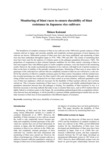Monitoring of blast races to ensure durability of blast resistance in Japanese rice cultivars
JIRCAS Working Report
| ISSN | 1341710X |
|---|---|
| 書誌レコードID(総合目録DB) | AA11159468 |

本文フルテキスト
jircas_working_report63-_1-9.pdf555.89 KB
The breakdown of complete resistance to blast in rice cultivars in the 1960s led to genetic analyses of blast resistant cultivars in Japan, and currently, partially and completely resistant genotypes of most Japanese rice cultivars are known. Differential systems of blast races have also been established, and monitoring of blast races has been undertaken throughout Japan in 1976, 1980, 1994 and 2001. The results of monitoring blast races have been used for the analyses of virulence genes in the pathogen population (Kiyosawa, 1985). The proportions of components in three released Japanese multilines for rice blast control, consisting of three to four near-isogenic lines with different genes to confer complete resistance, were also based on the monitoring results. Moreover, the results accelerated development of rice cultivars with high levels of partial resistance to blast on the basis of stability of the partially resistant genotypes. Monitoring of blast races in areas where the genotypes of the cultivated rice cultivars that are completely resistant to blast are not well known, is also useful for the selection of effective complete resistance genes for blast control. Inoculation with the isolated races has revealed promising rice cultivars for blast control with some showing partial resistance. Although monitoring of blast races has been conducted for rice blast control in several countries, sufficient quantitative analyses of blast race epidemics, which are necessary for the durability of blast resistant cultivars, have not been carried out. This is because monitoring of blast races is very laborious and reliable epidemiological data on population interaction between host and pathogen is lacking. For durability of blast resistance in rice, it is therefore necessary to develop methods that make it easy to monitor blast races, such as DNA markers that are tightly linked to avirulence genes in the fungus. By accumulating epidemiological data on population interactions between host and pathogen, it will be possible to construct reliable epidemiological models that can simulate increases in blast races in host populations with different degrees of resistance.
| 刊行年月日 | |
|---|---|
| 作成者 | Shinzo Koizumi |
| 著者キーワード | monitoring blast races durability of resistance rice |
| 巻 | 63 |
| 開始ページ | 1 |
| 終了ページ | 9 |
| 関連するリソース | 部分である : JIRCAS Working Report no.63 |
| 言語 | eng |
関連する刊行物
部分である
